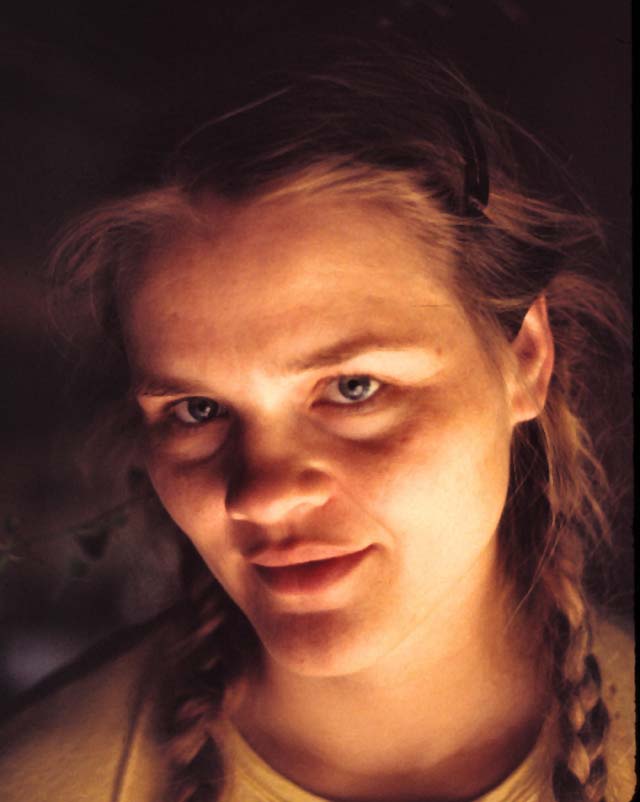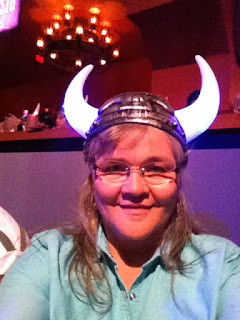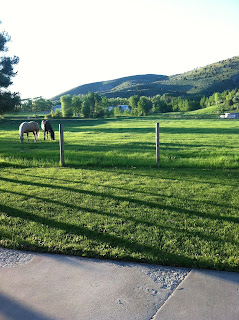Really, I'm still around. But, that's part of why this blog has had no new posts: I've been
around! After the Oregon graduation, I returned to finish the last crazy three days of school. We did the usual: awards assembly, memory book autographs, cleaned out our desks. Then on the final day, it was Pancake Day and stack-up-the-desks and all the final fun moments of The Last Day of School. We teachers rushed about filing, filling out, packing up and tearing down. I checked out from my school on Thursday afternoon early, went home and unloaded a couple of boxes of junk.
Then, I pack my suitcase and hopped in the truck for the drive north. On Friday, I attended a beautiful wedding for my niece at the Salt Lake Temple. On Saturday, I drove even further north for the reception in their family's exquisite yard in the most beautiful place in the world in June: Star Valley, Wyoming. Don't believe me? Just look:
I also got to hang out with family members and line up for the photo that we've been taking for nearly fifty years:
June 2013
December 1963
Yes, there are only seven of us in each photo. In the top photo, we're missing Trish, who left us eight years ago. In the bottom photo, we don't yet have Shelly, the mother of the bride in the top one.
So, after the wedding fun, I drove half-way back to my daughter's house in Utah, then stayed in a motel. The next morning, I drove the final two hours and we attended church. My son's family came down for dinner that evening. Much playing and shrieking followed in the basement while the adults talked and laughed up stairs. Monday, I had a wonderful day with an old friend, talking and eating and catching up. Tuesday, I loaded up a couple of grandchildren and we headed south for the desert. It was Grandma Camp time!! Stay tuned tomorrow for more adventures.
But today, enjoy the Summer Solstice---the Longest Day of the Year. That fine, fine day when sunshine rules and cold darkness drools. I'd really love to go to Stonehenge some time on June 21st and watch the celebrants. But, mostly, it would be to honor those ancient ones who recognized how delightful it is to enjoy the sun on this great day of its Northern Hemisphere apex. Yes, yes, now the days will gradually grow shorter and we will be aware of that in a few weeks. But, today, revel--glory--celebrate with swimming, picnics, hiking, whatever. Enjoy Old Sol. Here's my take on those two photos up there: Winter vs Summer in Star Valley, Wyoming.
(In the early 90's, I was enrolled in college to finish a bachelor's degree and one class was a writing course. I learned a great deal from that teacher, so I'll always appreciate my time there. The other reason it was a great experience is that it forced me to write regularly. Here's an essay from that class in which I had to compare/contrast something.)
Milking in January or June
Growing up on a dairy farm, I had the cow milking as an ever present part of my life. It was as constant as the change from darkness to day, as the sunlight spilled over the mountains that formed the backdrop to our farm. Every day it happened: the cows never had a vacation. The only thing that changed was the weather--the extremes of the region creating a dramatic contrast in the conditions of our never-ending ritual.
Winter prevailed for more than half of the year. It made milking cows in our old wooden barn an endurance contest. Each January afternoon the school bus deposited us at home and, with great determination, my sister and I would resolve to get right out to the barn. The sooner we got to it, the sooner we could be finished. But, once inside the house, it was so hard to leave. If mama had baked cinnamon rolls or cookies, the air smelled so enticing. Even the damp, clean scent of the drying laundry, hung in the stairway, created a coziness that drew us closer to the heater and slowed the donning of our chore clothes, chilled from hanging on the porch.
I pulled on layer after layer---thermal, denim, knits---whatever I thought could ward off the outdoor chill visible in the ice crystals creeping up the inside of the kitchen window. Two or three socks on each rubber-booted foot, a dishtowel tied around my hair and arms jutting out from my sides because of the thick layers, I stepped out the door with the house-milk bucket swinging from the crook of my arm, while my hands hid in my pockets.
The first breath of that tingling air shocked my lungs, and my nose and cheeks immediately began to chill. The sun was still hovering over the west hills, but its pale light was useless as a source of warmth. The atmosphere was thin and brittle, and the snow squeaked dryly under my feet. I walked quickly to the barn just to get under shelter and hopefully find relief from the sharpness of the cold. Leaving the bucket in the milkhouse, I went through the gate to fetch the cows from their housing shed. Even the cows were reluctant to come out on a night like that. I had to prod, coax and threaten them with the dog to roust them from the the coziness of the shed where their collective warmth and moist breath gave a foggy boost to the temperature by many degrees over that outside.
Tripping over frozen cow pies in the gathering twilight, I slipped and trudged behind them as we approached the barnyard. By now, my dad, finished with the school bus route, was on his way out, similarly bundled, to refill all the feed mangers and carry loads of hay to sustain the other animals in the rest of the pastures. We exchanged signals, not wanting to open our mouths in greeting because then the cold air went straight into our chests without any prewarming.
If the vacuum lines weren't blocked by ice, the milking proceeded smoothly. During the few minutes it took each cow's milk to be extracted into the machine's bucket, I slid my freezing hands into the warm place between her leg and udder until my fingers tingled, signifying the return of blood flow. With the outside temperature dropping to a negative twenty-five degrees and only the wooden walls of the barn to protect us, I appreciated the living hand-warmers.
If it was storming, I had another sensory delight: dripping snow sliding off the cows as they warmed up standing in the stalls awaiting their turn. It usually landed right on the back of my neck and quickly slid down inside my coverall. Often an irritated animal would stamp her foot and flick her tail threateningly This was a tail that ended in a mass of of ice coating each hair so that you could hear clicking as it flew through the air, straight for your face.
At long last, the two hours came to an end. I turned the last cow out to return to her warm bed, washed out the milkers, and put the cans of warm milk in the cooling trough, always stepping with great care to avoid slipping on the thick sheet of ice that inevitably coated the cement floor of the milkhouse. As I turned out the lights and crossed the barnyard by the light of the millions of stars shining over the brittle landscape, just seeing the glow from the house windows began to warm me, knowing I'd be inside in moments, comfortable---for another ten hours at least.
One might ask, "How could you endure this, twice a day, for the whole winter?" Because I knew that winter would end, and spring would come and so would June. June in Star Valley, Wyoming was worth the entire seven months of winter. Summer had truly come by June with leaves on the trees, flowers blooming, pastures lush with grass, and long, warm days.
At milking time in June I was almost grateful for an excuse to be outside. A refuge in winter, in the summer our house was only a barrier to the sensory pleasures of the outdoors. Dressed only in cut-off jeans and a light blouse, barefoot in my rubber boots, I cheerfully whistled up the dog to accompany me up the field to call in the herd of cows. I broke off a sprig of lilacs as I went through the gate, and buried my face in the sweet purple trumpets clustered along the twig. I could see the cows had wandered halfway to the mountain. They were scattered across the deep green landscape: fawn colored Jerseys, orange and white Guernseys, and the standard black and white Holsteins, grazing in clover up to their ankles. Meadowlarks, perched on the fence posts whistled their distinctive melody as a mother kill-deer ran along in front of us, doing the broken wing diversion, to keep us from her babies nestled in the tall grass by the ditch.
The sun was low enough in the sky to be comfortable, but the evening chill had not begun. The heat of the day rose up from the grass and combined with the slight dust from the herd's hooves as they trailed leisurely down the road to the barnyard, sending a soft cloud shimmering aloft. Through this cloud a flock of tiny white and yellow butterflies swirled, disturbed from their resting place as the cows passed.
In the barn, with the top half of the divided door open, the sunbeams stretched through the hay dust from the loft and striped the cows as they stood, sleek and clean from living outdoors, away from the close quarters of the sheds. Their sun-warmed hides felt soft against my bare arms as I crouched down to attach the milkers. Waiting for the milk, I gazed out the open door watching lambs caper in the adjoining field. The cats, bulging from the day's mouse hunt, twined around my ankles purring for warm milk in their dish. Since no one but cows could hear, I usually sang Rogers and Hammerstein songs. Sometimes, I brought my mother's radio out and tuned into rock and roll before the sun set and the station went off the air.
Even when all the clean-up was finished, and the milkhouse floor was swept dry, I lingered outdoors. I'd go for a ride on my horse, or play softball with my sister, or hang around on the lawn watching my mother work in her flower beds. The sun went down behind the mountains, but twilight lasted for another hour. It was the best time of day to swing, or pull tiny carrots from the garden. As it got darker, we'd scare ourselves with a game of "No Bears Are Out Tonight." Only the total darkness finally forced us inside.
June was a month to be outdoors. January is a month to live in Southern California.



















